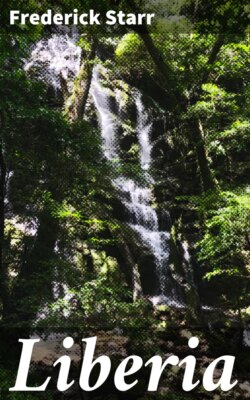Читать книгу Liberia - Frederick Starr - Страница 6
На сайте Литреса книга снята с продажи.
Political Geography.
ОглавлениеTable of Contents
—1. The name Liberia was suggested in 1824 by Robert Goodloe Harper, of Baltimore, Maryland, and has reference to the fact that the colony was established as a land of freedom; the capital city, Monrovia, was also named on his suggestion in honor of the president of the United States at that time, James Monroe. The Republic of Liberia is divided for administrative purposes into four counties—Montserrado, Grand Bassa, Sinoe, and Maryland. These are named in order from west to east. The portion of Montserrado County lying around Cape Mount forms a territory with Robertsport as its capital and chief city.
2. It is difficult to learn reliable facts regarding the population of Liberia. Sir Harry Johnston made a careful estimation of the number of Americo-Liberians, listing each of the settlements and stating their probable number of inhabitants. He found the total to be 11,850 persons—or in round numbers 12,000; he estimated that there were 30,000 natives who had been more or less in contact with the white man and knew something of English or some other European language and of civilization; he estimated the total of untouched native population at 2,000,000 persons. Delafosse, an exceptionally cautious observer, claims 30,000 civilized inhabitants. Gerard raises the citizen mass of the Republic to 80,000 persons, of whom 20,000 are Americo-Liberians and 60,000 are natives who have submitted themselves to the laws of the country. It is certain that Sir Harry’s estimate of the number of interior natives is at least double the reality; so far as the other elements of population are concerned, he is probably somewhat near the facts, although it is likely that his number of 12,000 Americo-Liberians is an underestimate.
3. Most of the Americo-Liberian settlements are on the coast, although there are a number along the St. Paul’s River and a few upon some of the other rivers. There are four cities in the Republic, with mayor and common council; Monrovia, Grand Bassa, Edina, and Harper. The townships are Robertsport, Marshall, River Cess, Greenville, Nana Kru, Cavalla. In order to reduce the expense of the government service, the Liberian government has limited the number of open ports where foreigners may trade. The open ports at the present time include the cities and townships above mentioned and also Manna, Nifu, Sasstown, and Fishtown. The remaining ports are open for trade to Liberians but not to foreign traders. They are, Little Bassa, Tobakoni, New Cess, Trade Town, Grand Kulloh, Tembo, Rock Cess, Bafu Bay, Butu, Kroba, Beddo, Pickanini Cess, Grand Cesters, Wedabo, Puduke, Garawé.
4. We reproduce Sir Harry Johnston’s table.[A] It appears to have been carefully made and deserves consideration. We happen to have another set of figures, however, which we can compare with his; we quote them from Ferguson’s Handbook of Liberia. In May, 1907, an amendment to the Constitution was submitted to the popular vote; 6579 votes were cast. Voters must be males of at least twenty-one years and owners of property; the population represented by them would surely be at least three times this number—which gives a minimum of 19,737. These figures, however, can not be depended upon without qualification, because no doubt “natives” were among the voters; in fact, when matters of importance, upon which public opinion is actively aroused, are voted on, the “brother from the bush” is mustered to the polls in considerable numbers. We copy the numbers voting at different settlements in column parallel to Sir Harry Johnston’s figures. Curious discrepancies occur, as for instance, cases where a larger number of votes were cast than Sir Harry’s figure, which is supposed to give the total number of population.
